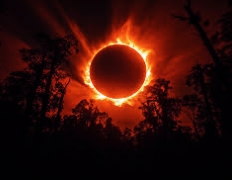
NEW DELHI: For those situated in the Moon’s shadow, a complete sun powered overshadow offers a stunning perspective, for researchers as well as for anybody planning to photo this divine peculiarity.
This is the way to take advantage of this occasion:
Focus on wellbeing: Never gaze straight toward the Sun without appropriate eye security, and the equivalent goes for your camera.
Utilize an exceptional sunlight based channel for your focal point while catching the fractional obscuration stages.
ALSO READ | Spotify-introduces-miniplayer-feature-for-desktop-users
However, make sure to eliminate the channel during entirety to catch the Sun’s crown in the entirety of its magnificence.
Use what you have: Incredible photographs can emerge out of any camera, be it a complex DSLR or a straightforward cell phone.
What makes the biggest difference is the picture taker’s expertise and imagination.
In the event that your stuff does exclude a zooming focal point, pick scene shots to record the evolving light.
“Having a couple of different bits of gear can likewise prove to be useful during the obscuration.
Utilizing a mount can assist you with balancing out the camera and try not to take foggy pictures when there is low lighting.
Moreover, utilizing a postponed shade discharge clock will permit you to previews without wiggling the camera,” the Nasa said.
Five Tips from NASA for Photographing a Total Solar Eclipse via NASA https://t.co/o4MCERYYMN
— Khary Penebaker (@kharyp) March 21, 2024
FaQ Section
What is the significance of a total solar eclipse for both scientists and photographers?
- A total solar eclipse offers a stunning perspective for both scientists and photographers situated in the Moon’s shadow.
What is the primary safety precaution to remember when photographing a solar eclipse?
- Never stare directly at the Sun without proper eye protection, and the same applies to your camera.
What type of filter should be used for the camera lens during the partial eclipse stages?
- A special solar filter should be used for the camera lens during the partial eclipse stages.
Why is it advised to remove the solar filter during totality?
- It is advised to remove the solar filter during totality to capture the Sun’s corona in all its splendor.
What is emphasized regarding the type of camera used for eclipse photography?
- Regardless of the type of camera used, whether it’s a DSLR or a smartphone, the photographer’s skill and creativity are what make the biggest difference.
What alternative approach is suggested for photographers who lack zooming lenses?
- For photographers without zooming lenses, landscape shots can be chosen to capture the changing light during the eclipse.
How can additional equipment such as mounts and delayed shutter release timers enhance eclipse photography?
- Using a mount can stabilize the camera and prevent blurry images in low lighting conditions, while a delayed shutter release timer allows for snapshots without camera movement.
What practical advice does NASA offer for photographers preparing to capture a solar eclipse?
- NASA suggests having additional equipment such as mounts and delayed shutter release timers to enhance the quality of eclipse photography.
Why is it important to stabilize the camera during eclipse photography?
- Stabilizing the camera is important during eclipse photography to avoid capturing blurry images, especially in low lighting conditions.
What role does creativity play in achieving great eclipse photographs?
- Creativity plays a significant role in eclipse photography, allowing photographers to experiment with composition and capture unique perspectives of the celestial event.



One thought on “NASA’s Top 5 Tips for Photographing a Total Solar Eclipse”